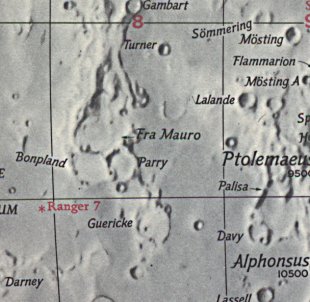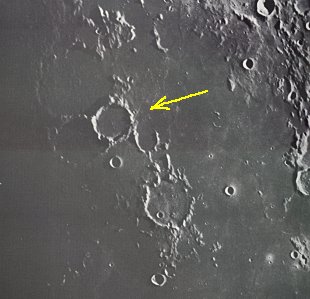Parry Lunar Sunrise Ray
Initial Reports
Observer: Tony Donnangelo
Date/time of observation: 2003/01/11 23:15 U.T.
Location of site: Hummelstown RD 3, PA, USA (40.26° N., 76.75° W.)
Site Elevation: 479 feet (146 meters)
Site classification: Suburban
Moon s age: 08d 14:51, 59% illuminated
Instrument: Takahashi FS-102
Magnification: 91x(9mm NaglerT6),158x(Pentax 5.2mm XL),
234x(3.5mm Vixen SW),
Object: Parry (crater)
Lunar ray coordinates: 8.0°S., 15.5°W.
Rukl Chart #: 43
This was a fascinating observation of three separate, simultaneously occurring rays in the same crater.
I set up my scope in preparation to observe the predicted lunar light ray in Hesiodus later that evening. I immediately noticed the three light rays in Parry. They were very thin shafts of light stretching across the total length of the completely shadowed flood floor of the 48 km crater.
The two rays in the northern half of the crater were fairly close together. In approximately 20 minutes, they began to widen, and appeared as one at lower magnification. At higher magnification, an extremely thin shadow was still visibly separating them. The ray in the southern half of the crater began to widen at the same time. Within an hour, the western half of the crater floor was illuminated, and the rays came to be shorter and more pie-shaped. Within approximately 2 1/2 hours, almost the entire floor was illuminated, and only remnants of the ray were visible. They were indistinguishable from their previous form.
The Initial Ephemeris, Using Data in Original Reporting
Site Longitude = +76.750
Site Latitude = +40.260
Feature = Parry
Feature Longitude: = -15.800
Feature Latitude: = -7.900
Reproducing Lighting For: 2003/1/11 at 11:15 U.T.
Desired Solar Altitude = -5.233(Rising), Azimuth = +91.816
Average Co-longitude = 10.516
Crater Description:
Parry, -268,-135: A ringed plain, 28 miles in diameter, adjoining Bonpland on the west, with fragmentary walls, but more complete than those of Fra Mauro or Bonpland. There are passes in the west, north and south walls, and some right craters on the interior. These are a little to the west of centre. Others exist on the south and north, together with a few craterlets and hillocks. Under the south wall is a wide cleft which, after traversing the floor, passes through a pass in the west wall and continues beyond, curving to the south. Another cleft crosses the floor close to the east wall, originating under the east wall of a bright crater, A, south of Parry. A is 7 miles in diameter and has a central peak. The cleft passes into Fra Mauro and crosses the floor of this formation. Dr. S.R.B. Cooke found another cleft running across the floor of Parry southwards from the north wall, where it passes through this portion of the rampart. (Wilkins and Moore, The Moon, Faber & Faber Ltd, 1955)


Return to Home or use your browser back button



